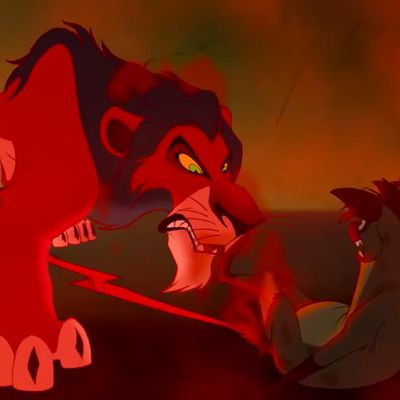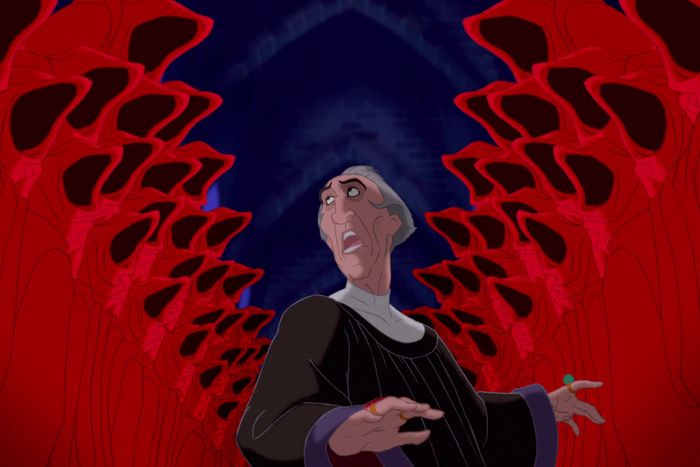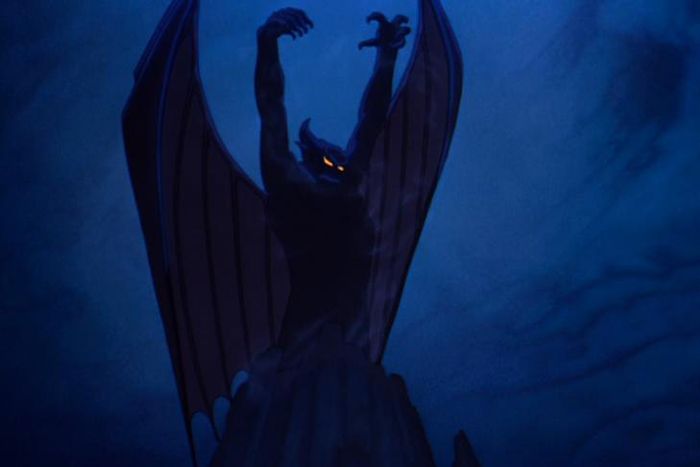
This article originally ran on July 23, 2019 when the remake of The Lion King was in theaters. We’ve republished it now alongside the release of Episode 3 of Land of the Giants: The Disney Dilemma, a Vulture-Vox Media Podcast Network collaboration that looks at the many facets and ever-changing fortunes of the sprawling entertainment company. You can listen to it here, and follow the entire series at the Disney Dilemma hub.
It was about halfway through 2019’s photorealistic remake of The Lion King that I found myself overwhelmed with grief. There I was, watching two lions limply cavort onscreen, in what looked like mildly interesting footage from a nature documentary, as “Can You Feel the Love Tonight” blared on the soundtrack. (Never mind the fact that the scene was set during the day!) Jon Favreau’s film had achieved something once thought impossible: creating digital animals so authentic they could have passed for the real thing. But in so doing, it reminded me of what was sorely missing from this newfangled version of The Lion King: Lines. Colors. Personality. Warmth. Wonder. What I suddenly longed for was a burst of hand-drawn animation.
Of course, such animation — the kind drawn by armies of animators, frame by painstaking frame — built the Walt Disney empire and aided in its resurgence in the late 1980s and early ’90s, known as the so-called Disney Renaissance. But the form seemed to die a slow, protracted death at the House of Mouse in the early 2000s. One might even say that the triumph of the original Lion King in 1994 — which, in terms of pure attendance numbers, comfortably remains the biggest animated film of all time — helped lead to hand-drawn’s demise. In the wake of that movie’s epochal success, the suits at Disney became more aggressive about their releases. They split the animation unit and pushed for faster timelines. They put out cheap, direct-to-video sequels to some of their most beloved titles, thus devaluing their brand. (Remember The Lion King 2: Simba’s Pride?) Meanwhile, event releases like Pocahontas, Hercules, and Mulan failed to replicate the success of The Lion King. By contrast, another Disney-affiliated company was bounding from success to success with computer-animated hits: Pixar had produced the first Toy Story in 1995, and within a decade it would have Monsters, Inc., Finding Nemo, and The Incredibles to its name.
“Pixar was doing really well and Disney films weren’t, and there was a general push in that direction,” says Amid Amidi, publisher and editor-in-chief of Cartoon Brew. “Of course, why they didn’t do well is another question. It wasn’t because hand-drawn wasn’t good, it’s because there were bad decisions at upper levels — too many layers of middle management, too much second-guessing, the typical filmmaking by committee.” Pixar was, famously, a filmmaker-driven studio, where animators and artists often collaborated on creative decisions. By contrast, Disney was being run by managers, executives, and accountants. You could see the difference in the respective movies they made.
Hand-drawn animation actually got tossed a lifeline when Disney bought Pixar in 2006. As part of that arrangement, Pixar co-founders John Lasseter and Ed Catmull were brought on to also lead Disney’s feature-animation division, and they soon rehired two legendary directors, Ron Clements and John Musker (The Little Mermaid, Aladdin), who began work on 2009’s lovely The Princess and the Frog, which unfortunately cost a lot and didn’t make back enough. The resurgence turned out to be short-lived: Disney released its last hand-drawn animated film, Winnie the Pooh, in 2011. In March 2013, CEO Bob Iger said there were no 2-D features left in development at the company; about a month later, its hand-drawn division was eviscerated and many veterans let go.
Traditional animation, the thinking went, had become too costly to produce. “I think that’s a lie they like to tell themselves,” says critic and Disney historian Josh Spiegel, who points out that, as much as The Princess and the Frog may have cost, its $105 million production budget was still lower than contemporaneous Pixar films such as WALL-E, Up, and Toy Story 3. But those Pixar movies made money. As did Disney’s own subsequent efforts, Frozen and Tangled, both of which had begun life years before as potential hand-drawn projects. Now, with the company’s 3-D animated features continuing to do blockbuster business alongside Pixar’s, there doesn’t seem to be any reason why the company would ever return to the traditional format.
But if Disney is going to continue on this “live-action” remake kick (and the initial box-office of 2019’s Lion King strongly suggests they will), don’t be surprised if more and more viewers are suddenly seized by a nostalgic hankering for hand-drawn animation and its unparalleled warmth. One need only look at Favreau’s picture, with its dissonant spectacle of lifelike animals forced to emote and talk like humans, to understand the expressive power of animation. And as much as I love the work of Pixar, which has given us nearly as many classics as Uncle Walt did in his golden years, the company has yet to make a film with the luminous sincerity and intimacy of Pinocchio, or Dumbo, or Beauty and the Beast.
Beyond that, Disney films also had a berserk sense of spectacle and showmanship that distinguished them. As brain-meltingly inventive as the best 3-D animated efforts have been, I’ve never experienced in any of them the unhinged delirium of The Lion King’s “Be Prepared” sequence, with its goose-stepping hyenas and agitprop lunacy, or of The Hunchback of Notre Dame’s “Hellfire” sequence, with its gyrating licks of flame and instantly materializing hordes of giant red monks.
There’s an airiness, a spontaneity to hand-drawn animation, which lends a playfulness to even the creepiest, most surreal imagery. Consider the “Friends on the Other Side” sequence in The Princess and the Frog, and its rapid-fire dance of floating heads, exploding skulls, and sinister swirls of fire and fog. If these elements had any weight or volume, they’d either be too terrifying or, more likely, too kitschy. Delivered as a two-dimensional, hand-drawn experience, it’s all fast and fun — like a thought briefly brought to life, then snatched back into the ether.
To be fair, showstopping numbers have often been a Disney trademark, and the studio’s later computer-animated titles like Frozen and Moana also have remarkable musical sequences. But they’re far more grounded. That is, in some ways, the magic of three dimensions — characters and objects have weight and shape and physical continuity, which makes it easier to believe that they exist in the real world, however fanciful they may be.
Traditional animation, by contrast, has the line, which shivers and shakes and strikes with the passion of the person creating it. Much as the brushstrokes of a painting can create a psychic connection with the artist who made them, line drawings still convey the power of an individual’s hand; they have a rough, human vitality. Somebody, we sense, created these pictures, and now the pictures are coming to life. Disney animator T. Hee once told a story about walking in on his colleague Bill Tytla while the latter was drawing the character of the Devil from the “Night on Bald Mountain” sequence of Fantasia. Tytla was so intensely wrapped up in his work, so possessed of a demonic fervor, that Hee quietly scurried out of the room. Watch the scene in question from Fantasia, and you can sense that energy emanating from the screen.
It has been said that when we watch actors, we watch somebody else having an experience, and that when we watch animation, we ourselves are having the experience. But we also sometimes sense the presence of another human speaking through that experience. Walt Disney himself represents a good case study for the power of personality as expressed through hand-drawn animation. He didn’t actually design many of his most famous creations — even Mickey Mouse was largely the work of early partner Ub Iwerks — and yet, Walt became practically synonymous with all of them. Part of this was the result of aggressive branding. But it was also because all these hand-drawn creations clearly had to be the work of somebody. The Walt Disney name, in other words, was built on the one-to-one connection created by his cartoons. (And it’s worth noting that, outside of Disney, other hand-drawn animators also became names in their own right. Think Chuck Jones, and Tex Avery, and Hayao Miyazaki, among many others.)
The celebrity animator was, ironically, another reason cited for the traditional form’s demise. In the mid-1990s, when Jeffrey Katzenberg left Disney to form DreamWorks, he began poaching talent from his former company. That led to an arms race in the industry, with animators getting paid larger and larger sums of money. To be sure, they probably deserved every cent of what they got, but when the films started failing, these inflated salaries provided even more reason for the company to let these employees go. Floyd Norman, a veteran of both Disney and Pixar (and the subject of the documentary Floyd Norman: An Animated Life), put it this way a few years ago: “What the studios realized was, ‘If we adopt this new CG filmmaking, we can get rid of all these damn artists.’ The era of the million-dollar animator has come to a close.”
But today, traditional animation itself is certainly not dead. Disney may have forsaken it, and much of Hollywood may have followed suit, but it remains the dominant form abroad, and on TV. That is cause for hope: That there are people out there still enjoying hand-drawn shows and films — the Japanese hit Your Name made more than $350 million worldwide in 2017, with only a tiny fraction of it coming from the U.S. — suggests that the audience hasn’t gone away. Much as they were in the 1970s and ’80s, before titles like The Little Mermaid inaugurated the Disney Renaissance, viewers are probably just waiting for the right movie to come along and show how it’s done. Or maybe, in the case of the most recent versions of The Lion King and Aladdin, how it isn’t done.





